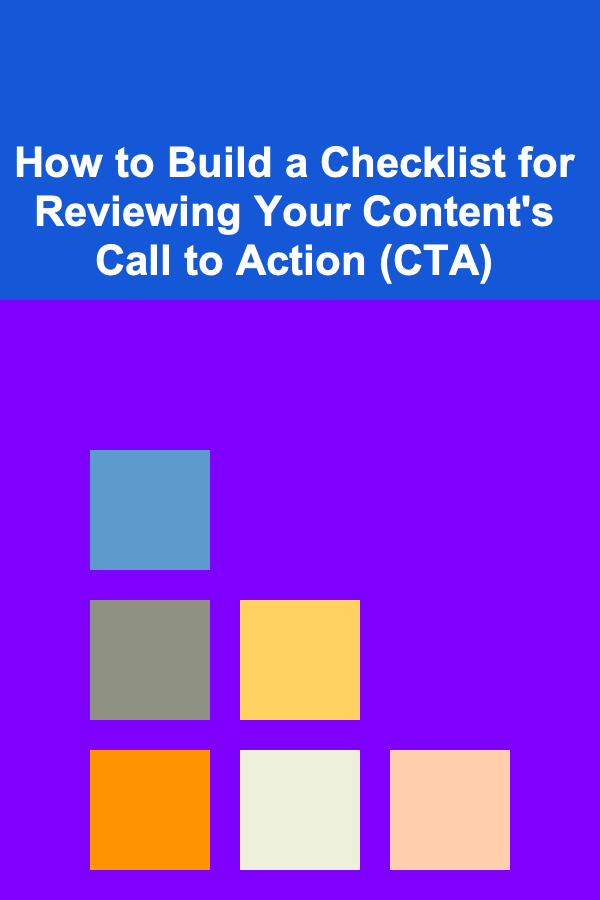
How to Build a Checklist for Reviewing Your Content's Call to Action (CTA)
ebook include PDF & Audio bundle (Micro Guide)
$12.99$7.99
Limited Time Offer! Order within the next:

Creating content that captivates and drives action is a crucial aspect of any successful marketing strategy. One of the most powerful components of your content is the Call to Action (CTA) --- the instruction that tells your audience what you want them to do next. Whether it's "Download now," "Subscribe," "Learn more," or any other action, your CTA plays a pivotal role in converting readers, visitors, or viewers into engaged customers.
However, a CTA can only be effective if it's designed and executed properly. To ensure your CTAs are maximized for success, you need a robust review process. This is where a well-structured checklist comes in. A checklist ensures that every aspect of your CTA is optimized and contributes effectively to your goals.
In this guide, we'll walk you through how to build a comprehensive checklist to review your content's CTA, ensuring that it not only attracts attention but also drives conversions.
Step 1: Understand the Purpose of Your CTA
Before reviewing your CTA, it's crucial to clarify its purpose. The effectiveness of any CTA depends on whether it aligns with the primary objective of your content. Is your CTA aimed at driving sign-ups, sales, engagement, or something else? Understanding the exact purpose of your CTA will help you evaluate whether it meets its intended goal.
Key Actions:
- Identify the goal: Determine what action you want the user to take after engaging with your content.
- Match CTA with content objective: Ensure the CTA supports the main objective of the content piece, whether it's to generate leads, build brand awareness, or prompt direct action like a purchase.
Why This Matters :
A clear goal ensures your CTA aligns with the overall content strategy, increasing the chances of successful conversion.
Step 2: Evaluate the Clarity and Simplicity of the CTA
One of the most important aspects of an effective CTA is clarity. Your audience should immediately understand what action they are supposed to take. Complex or ambiguous language can confuse users, causing them to abandon the action altogether.
Key Actions:
- Use direct, clear language: Phrases like "Click here," "Buy now," or "Sign up for free" are straightforward and easy to understand.
- Avoid jargon: Ensure the wording is simple and speaks to the average user, especially if your target audience may not be familiar with technical terms.
- Be specific: The CTA should convey exactly what the user will gain by clicking. Instead of just "Learn more," use "Learn how to grow your business in 30 days."
Why This Matters :
Clarity in your CTA removes barriers for the user, making it more likely that they will take the desired action.
Step 3: Ensure the CTA Stands Out Visually
A CTA must be easy to spot. If your CTA is buried within a mass of text or lacks visual contrast, it may go unnoticed, even if the message is compelling. Effective CTAs often use color, size, and positioning to draw attention.
Key Actions:
- Contrast the CTA: Use colors that stand out from the rest of the content, ensuring the CTA catches the eye.
- Make it prominent: The CTA button should be large enough to be noticed without being overwhelming. Ensure it's placed where users naturally focus, such as above the fold or at the end of the content.
- Whitespace: Surround the CTA with enough space to make it look distinct and avoid visual clutter.
Why This Matters :
Visual prominence increases the likelihood that users will notice and interact with the CTA, which drives action.
Step 4: Ensure Action-Oriented Language
A CTA should use action-oriented language that creates a sense of urgency or excitement. Words that motivate the reader to act now, rather than later, can make a significant difference in conversion rates.
Key Actions:
- Use strong action verbs: Phrases like "Get started," "Grab your offer," or "Claim your free trial" create a sense of urgency.
- Include time-sensitive language: Add phrases like "limited-time offer," "before it's gone," or "today only" to create a sense of urgency.
- Focus on benefits: Instead of just telling people what to do, show them what they will gain by taking action.
Why This Matters :
Action-oriented language encourages users to take immediate steps, boosting the likelihood of conversion.
Step 5: Make the CTA Mobile-Friendly
In today's digital landscape, more users are browsing and interacting with content on their mobile devices. It's crucial that your CTA is mobile-responsive and functions well on smaller screens.
Key Actions:
- Test CTA on mobile devices: Ensure the CTA is easy to click and stands out on mobile screens, where space is limited.
- Optimize button size: Make sure the CTA button is large enough for users to tap comfortably, avoiding frustration.
- Responsive design: Check that the CTA's design adapts properly to different screen sizes.
Why This Matters :
A mobile-friendly CTA ensures that users on any device can engage with your content, which is increasingly important given the rise of mobile browsing.
Step 6: Align the CTA with User Intent
The CTA should match the user's stage in the customer journey. If a user is in the awareness stage, a CTA like "Learn more" might be more effective than "Buy now." If they're closer to making a decision, a CTA that emphasizes urgency or a special offer can be more compelling.
Key Actions:
- Map the CTA to the user's journey: For early-stage content, provide educational CTAs; for later stages, offer more conversion-focused actions (e.g., "Shop now" or "Get your free quote").
- Match the content type: If the content is a blog post or informational article, CTAs like "Download the full guide" or "Subscribe to updates" are appropriate.
- Segment CTAs based on user behavior: Offer different CTAs for users who have already interacted with your site before versus first-time visitors.
Why This Matters :
Tailoring your CTA to the user's intent and stage ensures higher relevance and conversion rates.
Step 7: Test Your CTA
A CTA is not something that should remain static. Testing different versions of your CTA is essential for determining which one performs the best. A/B testing, for example, allows you to compare two different CTAs and understand which one generates more engagement.
Key Actions:
- Conduct A/B tests: Test different wording, design, colors, and placement to see which elements resonate best with your audience.
- Track performance: Use analytics tools to measure the click-through rates (CTR) of your CTA and other key metrics.
- Iterate: Based on test results, continually tweak and refine your CTA for better performance.
Why This Matters :
Ongoing testing helps you optimize your CTAs over time, ensuring that they're always as effective as possible.
Step 8: Ensure the CTA Leads to a Relevant Landing Page
Once users click your CTA, they should be directed to a landing page that matches the promise of the CTA. If there's a disconnect between the CTA and the landing page, users may abandon the action and lose trust in your content.
Key Actions:
- Match the CTA with the landing page: The content and offer on the landing page should align with the CTA. For example, if the CTA is "Get started for free," the landing page should emphasize a free trial or similar offer.
- Minimize distractions: Ensure the landing page is focused and free of unnecessary elements that could take users away from the intended action.
Why This Matters :
Ensuring consistency between your CTA and the landing page boosts user trust and improves the likelihood of conversion.
Conclusion
Creating an effective Call to Action is crucial for driving conversions and achieving your content's objectives. By building and using a checklist to evaluate your CTAs, you can ensure that every aspect of your CTA is optimized for maximum impact. Whether it's clarity, visual prominence, urgency, or alignment with user intent, each factor plays a vital role in motivating your audience to take action. Regularly reviewing and testing your CTAs will keep them fresh and effective, ultimately helping you achieve greater success in your marketing efforts.
Reading More From Our Other Websites
- [Survival Kit 101] Top 10 Emergency Preparedness Kits for Home and Travel
- [Biking 101] Top 5 Downhill Bikes for Thrilling Rides and Performance
- [Home Space Saving 101] How to Save Space with Stackable Storage Solutions
- [Organization Tip 101] How to Organize Your Office Supplies for a Tidier Workspace
- [Home Space Saving 101] How to Store Seasonal Items Without Taking Up Valuable Space
- [Personal Care Tips 101] How to Know When It's Time to Switch Your Antiperspirant Brand
- [Home Lighting 101] How to Light Your Home for Different Seasons and Holidays
- [Organization Tip 101] How to Create a Custom Labeling System for Your Pantry
- [Organization Tip 101] How to Optimize Lighting for Safety in Your Entryway
- [Hiking with Kids Tip 101] How to Choose the Perfect Feather-Light Backpack for Your Child's Trail Trips

Creating a Sustainable Passive Income with Deep Learning
Read More
How to Create a Family Bucket List and Check Off Activities
Read More
How to Find Peace in the Midst of Change
Read More
How to Avoid Common Dating Mistakes
Read More
How to Talk About Climate Change Effectively
Read More
10 Tips for Developing a Consistent Printmaking Style
Read MoreOther Products

Creating a Sustainable Passive Income with Deep Learning
Read More
How to Create a Family Bucket List and Check Off Activities
Read More
How to Find Peace in the Midst of Change
Read More
How to Avoid Common Dating Mistakes
Read More
How to Talk About Climate Change Effectively
Read More